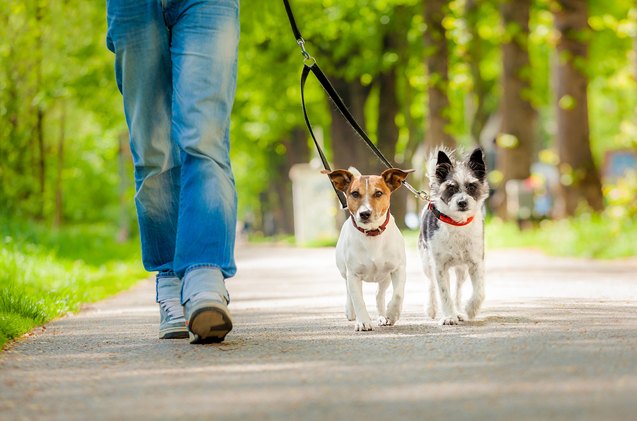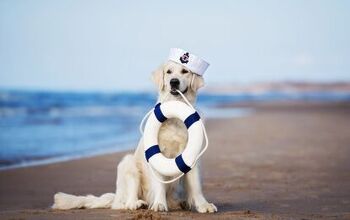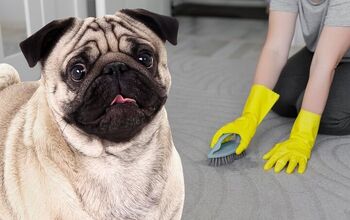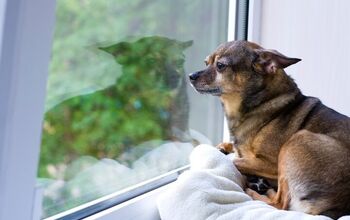How To Avoid Fido Fiascos When Training Multiple Dogs

Having more than one dog can be either a blessing or a curse. It’s a blessing in that they wear each other out and take much of the stress of having to exercise them off the owner. It can be a curse in that they can pick up each other’s habits and feed off of bad behavior. I’ve seen it countless times in my profession. As an example, I knew of a family that had one dog who was an angel, but they felt bad leaving him alone all day. The solution: they adopted another dog so they could keep each other company. It wasn’t long before everything in sight was chewed up, started off by the new addition, and soon followed by the former angel (turned willing accomplice).
This problem could have been nipped (or chewed) in the bud before both dogs when on a chewing frenzy. Here are a few tips to keep in mind when you’re training multiple dogs.
Related: Teach Your Dog The Recall Command
Name Importance
When you have more than one dog, it’s important that they recognize their own name. I know it seems silly, but it’s not as if dogs intrinsically know their own name. They hear a word and there’s a response: either something good happens or something bad happens. It’s essential from the beginning to teach each dog to distinguish their own name. This can be achieved easily by calling the dog’s name, and then treating when they give you their focus. To start, practice this exercise in separate rooms with individual dogs, until they understand their own name. Once this feat has been accomplished, graduate to practicing together with the pack.
Separation Anxiety
One of the most common issues I see in multi-dog households is separation anxiety. And it’s not necessarily separation anxiety with their humans, but between the dogs. While you’re away at work all day, your pups spend all their time together. They eat together, play together, sleep together, and wait for you to come home together. Chances are they will bond more to each other than to you. This is where the problem comes in. Dog 1 rolls in something dead in the backyard and stinks. The natural response is to take Dog 1 to the groomer for a bath. On the way there, you wonder why Dog 1 starts anxiously panting in the car when he normally loves car rides. To top it off, you get home from the abnormally stressful trip to find the house chewed to bits. This is because they are too attached to each other and have a fear of being separated. The solution is to separate them occasionally from the moment they come into your home. It’s a good idea to separate them occasionally for walks, car trips, play time and other activities so they adapt to being separated.
Related: Ways To Deal With Dog Separation Anxiety
Separate Training
Dogs learn at different paces, so make it easy and spend some time training with your dogs alone. This will help to encourage the bond between you and the individual dog, and it will help them retain their place in the home. It will also ensure that they don’t pick up each other’s bad habits during training time.
Putting It All Together
When you have two dogs, you have to do everything in two steps: first separate, and then together. Spend equal time training them, even if Dog 1 is already a super star who can do algebraic equations. Once they get to a comfortable learning level (the basics are mastered in both dogs), bring them together for a group training session so they can learn to work together, with you in charge.
These tips work best in a situation where dogs already get along well together. If you are just in the beginning stages of introducing a second dog into the home, go slow and don’t take chances. If problems arise, consult a professional immediately before things get out of hand.
Otherwise, you’ll find that these steps will help your raise a household of happy hounds (and allow you to save your wine for happier occasions).
Rachel Leavy lives in Rochester, New York with her dog, Maria, and her gecko, Nigel. She has loved animals all her life, and has owned her own dog training and walking company for five years. When she’s not playing with puppies, she can usually be found writing short stories, riding horses or out at a play.

Rachel Leavy lives in Rochester, New York with her dog, Maria, and her gecko, Nigel. She has loved animals all her life, and has owned her own dog training and walking company for five years. When she's not playing with puppies, she can usually be found writing short stories, riding horses or out at a play.
More by Rachel Leavy
























